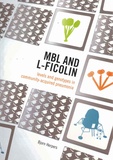MBL and L-ficolin
Levels and genotypes in community-acquired pneumonia

Herpers, Bjorn
- Promoter:
- Prof.dr J. (Jan) Verhoef & prof.dr J.A.G. (Jos) van Strijp
- Co-promoter:
- Dr B.M. (Bartelt) de Jongh & dr G.T. (Ger) Rijkers
- Research group:
- Strijp
- Date:
- April 21, 2011
- Time:
- 10:30 h
Summary
Intriguing advances have been made in recent years in identifying the mechanisms and consequences of genetic diversity and immune defects of pattern recognition receptors in innate immunity. The subject of this thesis is the interplay between the gene, protein and disease for two of these receptors: mannose-binding lectin (MBL) and L-ficolin. By studying genotypes, protein levels and functionality in a cohort of hospitalized patients with community-acquired pneumonia and in an outbreak of legionellosis, we aimed to obtain more insight into the reciprocal effect of these proteins and pneumonia on each other, in the light of the genetic background of the patients. Both MBL and L-ficolin are part of the complement system of innate immunity, sharing similarities in structure and function. Both proteins have trimeric collagen-like subunits assembled into higher order oligomers, held together by disulfide bridges at the cysteine-rich N-terminal domain. The multimeric structure exposes multiple ligand-binding C-terminal heads: carbohydrate-recognition domains for MBL and fibrinogen-like domains for L-ficolin. This enables the binding of repeating molecular patterns on pathogens with high avidity, resulting in complement activation and in opsonization for phagocytosis. Multiple genetic polymorphisms in the gene encoding MBL lead to impaired oligomerization, resulting in deficiency of functional MBL. The gene encoding L-ficolin revealed to be highly polymorphic as well, with two single nucleotide polymorphisms (SNPs) leading to an altered substrate binding affinity of the protein. Both genes harbor promoter SNPs that influence plasma protein levels. MBL deficiency has been associated with an increased risk in infection. Conflicting results have been published on the effect of MBL deficiency on pneumococcal infections. In our cohort of community-acquired pneumonia, we did not find an association between MBL genotypes and pneumococcal infection. MBL-sufficient genotypes were more frequently found in a small group of patients with atypical pneumonia. In a large outbreak of legionellosis at a Dutch flower show, MBL genotypes were not a risk factor for legionellosis. However, patients with legionellosis displayed deficient MBL-mediated complement activation even with MBL-sufficient genotypes. Together, these genotypical and functional data suggest that the observed deficiency of lectin pathway activation is an effect of legionellosis rather than a risk factor for acquiring it. MBL and L-ficolin both revealed to act as acute-phase reactants in community-acquired pneumonia. However, the effect of genetic variants on this response differed between the two proteins. With MBL, the acute phase responsiveness was highly dependent upon the genotype. With L-ficolin, the genotype only determined variations in the protein levels, not in the acute-phase responsiveness itself. At the first glance MBL and L-ficolin look very much alike, with similar protein domains, multimeric structure, pattern recognition and complement activating properties. Yet the small differences in exactly these characteristics may give rise to essential differences in biological function, and this might have driven the different evolutionary strategies in shaping polymorphisms of the genes. In their similarities and differences, MBL and L-ficolin are an excellent example of one of nature’s successful strategies: creating necessary redundancy, without unnecessary abundance